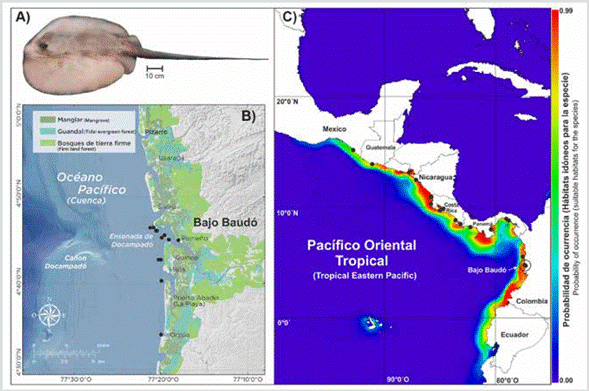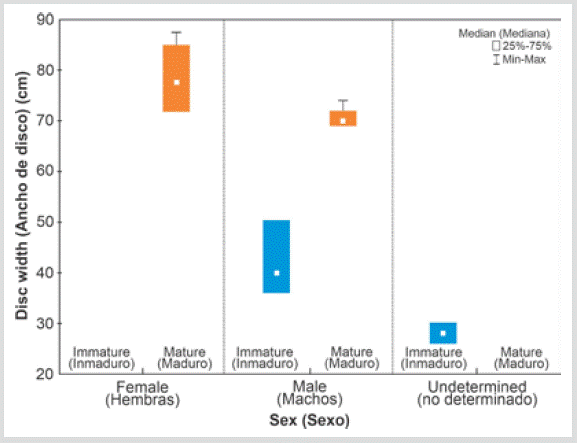The Potamotrygonidae family is endemic to the Neotropical region and is currently divided into two subfamilies, Potamotrygoninae and Styracurinae (Carvalho et al., 2016). For the Potamotrygoninae subfamily four genera and 41 freshwater species are currently recognized, exclusively distributed in South America (Silva and Loboda, 2019). Based on the phylogenies resulting from morphological and molecular studies, the Styracurinae subfamily and its only genus, Styracura, were recently erected by Carvalho et al. (2016) for Trygon schmardaeWerner, 1904 (type species) and Dasyatis pacificusBeebe and Tee-Van, 1941, both previously located in the genus HimanturaMüller and Henle 1837. Unlike freshwater stingrays (Potamotrygoninae), the two recognized species of Styracurinae, Styracura pacifica (Pacific chupare stingray) and S. schmardae (Caribbean whiptail stingray) inhabit shallow marine and brackish waters, especially in estuaries and mangroves (Lovejoy et al. , 2006; Last et al. , 2016; Palmeira and Nunes, 2020). Little is known of their biology and diet (Last et al. , 2016), and given their high morphological similarity, they are considered Amphi-American species (Lovejoy, 1996; Carvalho et al., 2016).
Styracura pacifica has been recorded along the Pacific coast of Central America, from Oaxaca, Mexico, to Panama, in muddy bottoms and shallow mudflats (up to 30 m) (Robertson and Allen, 2015). However, its presence around the Galapagos Islands (Allen and Robertson, 1994; McCosker and Rosenblatt, 2010; Hearn et al., 2014) seems doubtful and needs to be confirmed. This species has been included in lists of elasmobranchs of Colombia (Mejía-Falla et al. , 2007; Mejía-Falla and Navia, 2019) based on records included in previous documents; nonetheless, to date, there were no voucher or support specimens for the full confirmation of their presence in the Colombian Pacific coast.
Throughout the Colombian Pacific, artisanal fisheries interact with several species of batoids, among which the families Dasyatidae, Rhinobatidae, and Aetobatidae stand out, all of them with local importance for their consumption and marketing (Mejía-Falla et al., 2017). From the participatory fisheries monitoring in the coastal zone of the Marine Protected Area (MPA) "Encanto de los manglares del Bajo Baudó (EMBB)", Chocó, carried out by Fundación MarViva (2018) and Wildlife Conservation Society (WCS, 2019-2020), the presence of a species of stingray, less common, but consumed locally and known as "raya corroñosa" or "raya lenguada" was recorded. This species did not appear in the previous records of fishery resources of the Colombian fisheries authority, probably due to its registry using vernacular names, which mask the catches of rare species within more frequent ones and with some morphological similarities, such as those of the family Dasyatidae.
The specimens examined for these rays (Figure 1A, "raya corroñosa") coincided with the description of the Pacific chupare stingray, Styracura pacifica (Carvalho et al., 2016). A total of 23 specimens of this species were caught in fishing operations carried out by fishers from the communities of Pomeño and Punta Hijuá, between March 2018 and February 2020. Catches were carried out in estuarine areas, shallow waters (between 2 and 11 m of depth) and muddy bottoms, mainly in the vicinity of the mouth of the Docampadó River (Figure 1B). Most of the specimens (20) were caught with longlines set at the bottom or at middle water, equipped with 40 to 400 J-type hooks, of sizes 6, 7 and 8, and using Pacific anchoveta (Cetengraulis mysticetus) and Pacific ilisha (Ilisha fuerthii) as bait. The other three specimens were captured with 180 m long gillnets, two of them with a 18 cm mesh eye, and the third one with a 9 cm mesh eye.

Figure 1 A) Specimen of Styracura pacifica or "raya corroñosa" [Spanish]. B) Collecting locations for S. pacifica in Bajo Baudó. C) Map of suitable habitats for the occurrence of S. pacifica in the Tropical Eastern Pacific (TEP). The red color indicates maximum probability (1) and dark blue indicates minimum probability (0) of occurrence.
The specimens had a disc width (DW) between 26.0 and 87.5 cm and a disc length between 49.0 and 87.5 cm. The total length (TL) could only be measured in three specimens (148 cm, 167 cm, and 185 cm), because the others had their tails cut off, a common practice carried out by fishers to facilitate the removal of nets and/or avoid injuries when handling animals. The total length recorded for two of the three specimens exceeds the known maximum length for S. pacifica in the literature (157 cm; Robertson and Allen, 2015). Further, 15 specimens showed DW wider than 62 cm, i.e., the maximum DW value previously reported by Robertson and Allen (2015).
The weight of 10 specimens ranged from 1.8 to 23 kg. Of the 23 specimens, 11 were female, nine were male, and on the other three, their sex could not be identified. Females showed larger sizes and weights than males. The DW of the females varied between 54.5 and 87.5 cm, and their weight between 12 and 23 kg, while the males varied between 36 and 74 cm DW and between 1.8 and 15 kg of total weight. Females larger than 71.8 cm DW and males larger than 69 cm DW were mature, while those smaller specimens (26 and 30.2 cm DW) were immature (Figure 2).

Figure 2 Sizes and maturity recorded by sex for the Styracura pacifica specimens captured in Bajo Baudó.
Styracura pacifica has not been adequately recorded in the Tropical Eastern Pacific (TEP). Only 33 geo-referenced records are available, dispersedly distributed from the southernmost coast of the Mexican Pacific (states of Oaxaca and Chiapas, Castro-Aguirre and Espinosa-Pérez, 1996) to the mouth of the Chepo River in Panama bay (Robertson and Allen, 2015). The current record confirms that the distribution range of the species extends at least 470 km further south (Figure 1C) and that the extent of its presence is 42,411 km2, representing a low value compared to other elasmobranch species of the TEP (Mejía-Falla and Navia, 2011). However, the potential distribution analysis based on known records and environmental data (Tyberghein et al., 2012) applying Maxent in ModestR (García-Roselló et al., 2013), suggests that S. pacifica has suitable habitats to distribute continuously from southern Mexico to almost the gulf of Guayaquil in Ecuador (Figure 1C). Moreover, the probability of occurrence of S. pacifica in the TEP is mainly influenced by average primary productivity and low salinities.
Finally, considering the low number of records in the region, its limited distribution, little knowledge about its biology, the degradation of mangroves (López-Angarita et al., 2016), and its possible interaction with artisanal fisheries throughout the TEP, it is probably that S. pacifica requires specific management actions, additional to those conferred by its presence in MPAs such as the EMBB.











 text in
text in 


